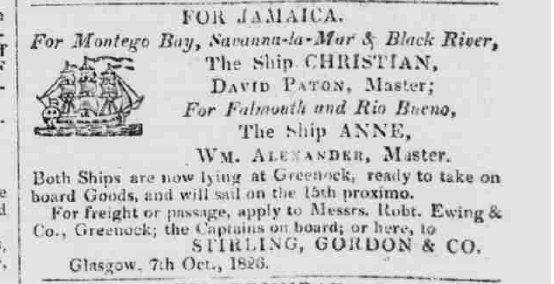The Launch of a West Indies Trader

Launch of the Christian by Robert Salmon c. 1818
T.1957.15
Images © CSG CIC Glasgow Museums Collection
2nd August 2022
I have long admired this painting by the famed marine artist Robert Salmon. It shows the sailing ship Christian being launched from the Greenock shipyard of John Scott on 2 October 1818. At this time shipbuilding on the Clyde was relatively small in scale, with only a few yards producing small numbers of wooden sailing ships. Steamships were a new invention and the small steamboat in the dark shadows of the foreground is a portent of things to come for the Clyde as it grew to became one of the world’s greatest shipbuilding rivers.
The Christian, at 450 tons and 117 feet (36 metres) long, was pretty big for a Clyde-built ship at this time and quite rightly its launch is being witnessed by a large crowd of onlookers. With the sun shining on the mighty ship, with its flags flying, poised to take to the water for the first time, I have always seen this painting as a wonderful celebration of Clyde shipbuilding at a critical stage in its development.
What I have only just realised is that this painting is also a celebration of slavery.
On its mainmast, the ship is flying a flag with the letters SG on it. This is the house flag of Stirling, Gordon & Company, a company that was formed in the mid eighteenth century to look after the interests of a number of Glasgow West India merchants and plantation owners. It expanded in 1795 when it took on two new partners from the Stirling family. John Stirling of Kippendavie, owned the Content plantation, and his distant cousin Charles Stirling of Cadder owned the Frontier and Hampden plantations. When the vehemently pro-slavery lobby group, the Glasgow West India Association, was formed in 1807 Charles Stirling became its chairman and other partners in the firm became members. For them, profit came before humanity.
The Christian was built to join Stirling, Gordon & Co.’s growing fleet of ships and was designed specifically to carry goods produced by enslaved people from Jamaica to the Clyde.
The ship is named after Charles Stirling’s wife, Christian, whom he married in 1817. Without knowing the family history of the Stirling family, casual observers would assume the name had religious connotations and so it lends a certain moral approval to the system of slavery.
Other flags flying proudly on the ship include the Scottish saltire, the Union Jack and the red ensign that was used by British merchant ships. Looking down from a tower is a statue of Admiral Lord Nelson, whose victory at the Battle of Trafalgar ensured that the Royal Navy could claim dominance over the world’s oceans and protect Britain’s colonial trade. This gives the message that here is a ship that is expanding Scotland’s role in the British Empire. The painting glorifies the commerce that is extracting wealth from the colonies.
The Christian began sailing between Greenock and Montego Bay on the north coast of Jamaica. On a typical voyage, as noted in the Glasgow Herald of 3 July 1826, Christian brought back a cargo consisting mainly of sugar and rum, but it also carried 25 tons of logwood that was used to make black and blue dyes, 5 tons of fustic used to make yellow dye, a few barrels of coffee and ginger, and a keg of tamarind.
 Advert for the Christian sailing to Jamaica. From the Glasgow Herald of 6 October 1826.
Advert for the Christian sailing to Jamaica. From the Glasgow Herald of 6 October 1826.
For over 30 years the Christian plied between Greenock and the northern ports of Jamaica, bringing back vast quantities of colonial goods for the sugar refineries, dyeworks and dinner tables of Clydeside. Christian therefore traded with Jamaica during the time of legalised chattel slavery, during the so-called ‘apprenticeship’ period between 1834 and 1838 when formerly enslaved workers were still bound to their former owners, and also during the post-emancipation era when indentured labourers were shipped from India to work the plantations.
Christian was eventually put up for sale at the end of 1851 and was sold to Troon shipowner Captain Thomas Fisher. He had operated ships to the West Indies, but his new ship was intended to trade with India. Things didn’t turn out well, though. Christian suffered serious damage in a storm in the Channel and when it finally arrived in Indian waters in July 1852 it was wrecked off the coast of Mumbai (Bombay).
Like so many objects in Glasgow Museums, this painting reveals a previously untold story of slavery and empire. I must have looked at it hundreds of times without realising what it really tells us. I now can’t look at it without imagining the suffering of so many enslaved Africans in Jamaica. And the obscene wealth that was created in Glasgow as a result of their labour.
Martin Bellamy,
Research & Curatorial Manager
